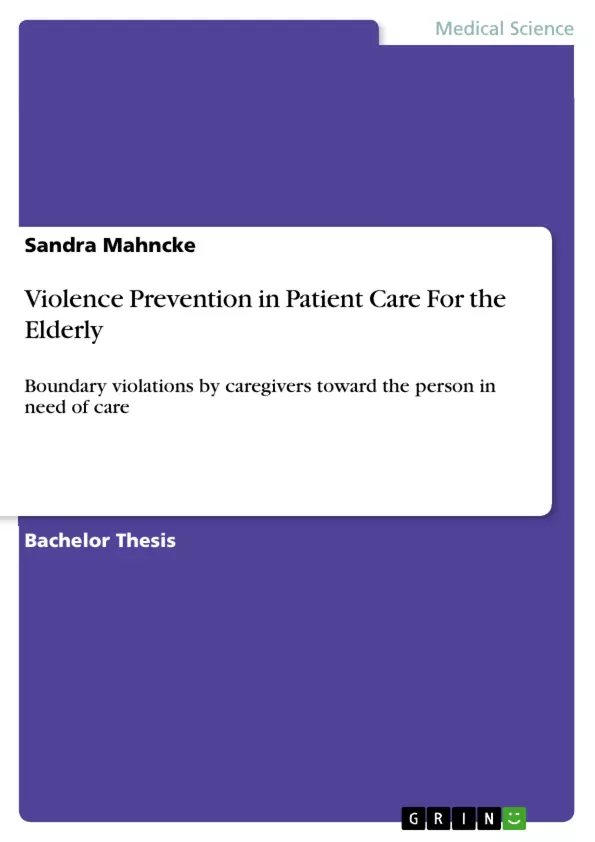I would like to show with this work, how violence and aggression in the stationary old person care by coworkers opposite care patients can be counteracted and by which indications coworkers ready for violence can be recognized early. Further I would like to explain the terms force and aggressions and which force - and aggression forms there are at all.
Thereupon I asked myself the question, which reasons, causes and triggers lead to force and aggression opposite protection inferiors and by which manifestations force can occur. Within my literature research I was looking for media reports about violence in inpatient geriatric care. Due to the low number of reports, my interest increased again and led to further questions.
Is violence in inpatient geriatric care communicated about or is it a taboo topic? At what point does violence begin? How far does an act of violence have to be carried out for the public to talk about it? Do the high demands on staff and the constant shortage of personnel lead to acts of violence against those in need of care? How can violence, perpetrated by nursing staff, be prevented? Is a concept of violence prevention in inpatient facilities helpful?
Inhaltsverzeichnis (Table of Contents)
- Introduction
- What is violence?
- Forms of violence against people in need of care
- Personal/direct violence
- Physical violence
- Psychological violence
- Financial exploitation
- Restriction of free will
- Neglect
- Structural violence
- Cultural violence
- What are aggressions?
- Physical forms of aggression
- Non-verbal forms of aggression
- Verbal forms of aggression
- Figures, data, facts - violence against people in need of care
- Reasons, causes and triggers of violence and aggression towards the person in need of care
- Overwork of the nursing staff due to the structural conditions
- Frustration of caregivers due to hierarchical ranking
- Excessive demands placed on caregivers by those in need of care
- Overwork of caregivers due to private influencing factors
- Frustration of caregivers due to insufficient income
- Burnout of nurses
- Prevention and solutions against violence and aggression against people in need of care
- Approaches from an operational perspective
- Further training and coaching
- Supervision
- Annual employee appraisals
- Personnel structures
- Spatial structures
- Scope for action
- Staff meetings
- Rewarding employees
- Approaches from a private perspective
- Self-help groups
- Family counselling
- Development of personal relief strategies
- Coping with burnout
- Dealing with aggression
- Approaches from the official point of view
- Medical Service of the Health Insurance Funds
- Residential and care supervision
Zielsetzung und Themenschwerpunkte (Objectives and Key Themes)
The purpose of this work is to explore the prevalence and causes of violence and aggression towards individuals in need of care, specifically focusing on the context of stationary geriatric care. It aims to identify effective methods for preventing and mitigating these behaviors, providing practical solutions for both caregivers and care recipients.
- Defining and classifying different forms of violence and aggression within the care setting
- Examining the underlying causes and triggers of violence and aggression, including factors related to staff workload, personal stressors, and organizational structures
- Exploring prevention strategies and interventions, focusing on operational, personal, and official approaches
- Highlighting the importance of recognizing potential signs of aggression and violence, emphasizing early intervention and support for caregivers
- Addressing the impact of demographic changes on the care sector and the critical need for preventative measures to safeguard both caregivers and care recipients
Zusammenfassung der Kapitel (Chapter Summaries)
The introduction provides personal motivation and contextualizes the significance of exploring violence in geriatric care. It highlights the growing need for preventative measures due to increasing demographic challenges within the care sector.
Chapter 2 delves into the definition of violence, examining various interpretations from diverse perspectives including conflict research, EU projects, and the World Health Organization. This chapter then explores different forms of violence that may occur against individuals in need of care, highlighting their multi-faceted nature and potential for overlapping manifestations.
Chapter 3 examines various forms of aggression, categorizing them as physical, non-verbal, and verbal. This chapter provides a deeper understanding of different behavioral manifestations of aggression in the care setting.
Chapter 5 focuses on identifying the reasons, causes, and triggers that may lead to violence and aggression directed towards individuals in need of care. This chapter examines various contributing factors including staff workload, hierarchical structures within care settings, personal stressors, and financial limitations.
Chapter 6 explores preventative measures and solutions to address violence and aggression in care settings. This chapter examines approaches from operational, private, and official perspectives, including further training, supervision, personnel restructuring, and the implementation of self-help groups and family counseling.
Schlüsselwörter (Keywords)
The central themes and keywords explored in this work include violence, aggression, geriatric care, caregiver burnout, prevention strategies, organizational structures, demographic change, and preventative measures. These concepts are examined in depth to provide a comprehensive understanding of the complexities of violence and aggression within the care setting.
- Citation du texte
- Sandra Mahncke (Auteur), 2014, Violence Prevention in Patient Care For the Elderly, Munich, GRIN Verlag, https://www.grin.com/document/1183368



